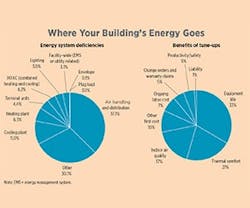Lighting Tune-Ups for Energy Savings
Small adjustments and repairs can make a world of difference in how well your building performs. Retro-commissioning is designed to root out such inefficiencies in buildings. However, it may be worth having the in-house facilities personnel examine the building first using some common commissioning targets.
These tune-ups recommended in ENERGY STAR's commissioning guide will set you on the path to optimal O&M practices.
Back to Basics
Some efficiency loss is inevitable as lighting ages, ENERGY STAR notes. However, losses due to poor control function, dirt, and lumen depreciation are avoidable with a few basic maintenance tasks.
Simply cleaning the fixtures and replacing burned out lamps and ballasts periodically will increase the light output of your fixtures, ENERGY STAR says. After this is accomplished, measure the light levels to see whether each space is lit correctly for the tasks performed in it. Consult the recommended illuminance levels issued by the Illuminating Engineering Society of North America (IES) to guide your way.
"Because space use and furnishings may change over time, it's important to match the lighting level to the current occupant requirements," ENERGY STAR adds. "Overlit or underlit areas should be corrected. Lighting uniformity should also be assessed, as relocation of furniture and even walls may alter lighting distribution."
Recalibrate Controls
Wrap up your in-house lighting audit with a look at your lighting controls. Make sure they were calibrated correctly when they were installed and check to see if anyone has tampered with them.
Likewise, any energy management systems, time clocks, or electronic wall box timers linked to the lighting should be programmed correctly so that the lights aren't coming on when the building is unoccupied. You may have to change the exterior lighting as well if the season has changed since the last time it was adjusted.
Cleaning can boost light output from 10-60% depending on the type of fixture and the cleanliness of its environment, ENERGY STAR notes. An energy use reduction of 50% or more is possible by recalibrating occupancy sensors and photocells.
Supplemental Loads
Is any office equipment left on in your building when no one is using it? If so, you have an easy opportunity to further reduce your building's energy consumption.
Supplemental load sources such as unused equipment that's still running can be reduced by encouraging occupants to shut down their computers or other equipment when they leave for the day, purchasing highly efficient office equipment (such as ENERGY STAR-labeled items), and enabling power management features wherever they're available.
Air infiltration through the envelope can also increase electrical loads unnecessarily, both through an increase in heating or cooling needs or by occupants combating problems themselves with space heaters or fans.
ENERGY STAR recommends a four-step process to cut down on air infiltration:
- Locate air leaks in the windows, doors, walls, and roofs.
- Ensure you use adequate sealing materials and techniques, such as weather stripping on doors, sealing and caulking on windows, and proper distribution of insulation in walls, ceilings, and roofs.
- Encourage people to use revolving doors if you have them. These doors cut down on drafts and the loss of conditioned air.
- Calibrate your automatic doors so that you lose less air from the envelope.
A large office building can save up to 5% on heating and cooling costs by reducing air infiltration, ENERGY STAR says. Whether performed as part of a retrocommissioning effort or an in-house maintenance program, such simple, easy fixes can make a world of difference to your energy spend.
